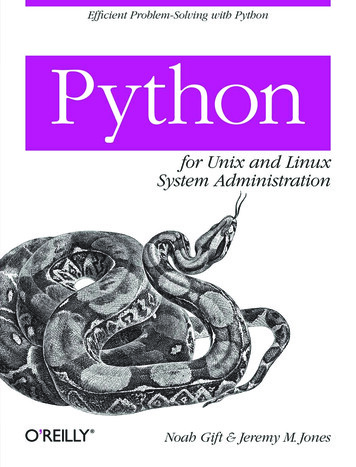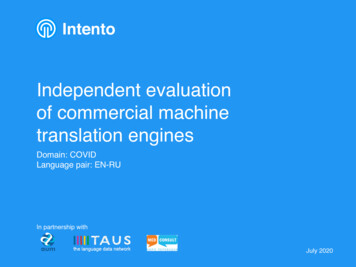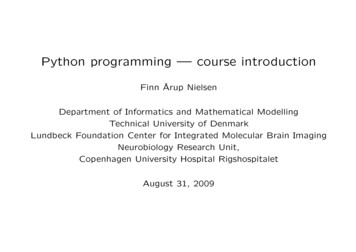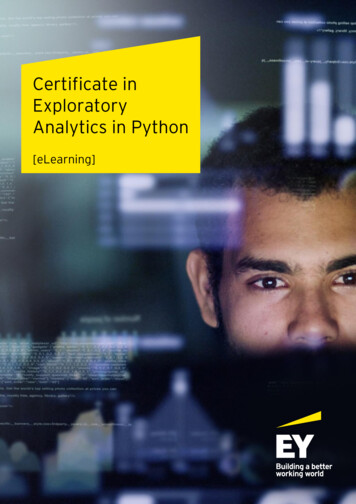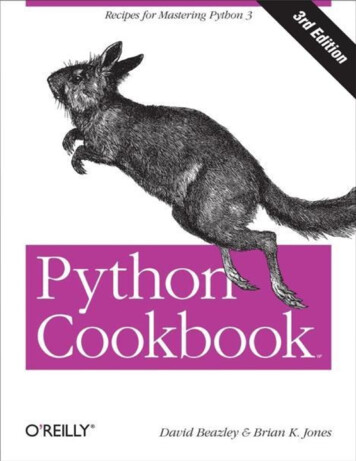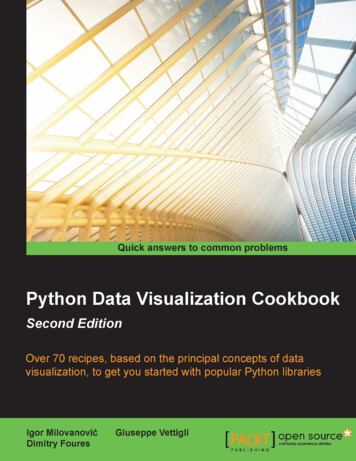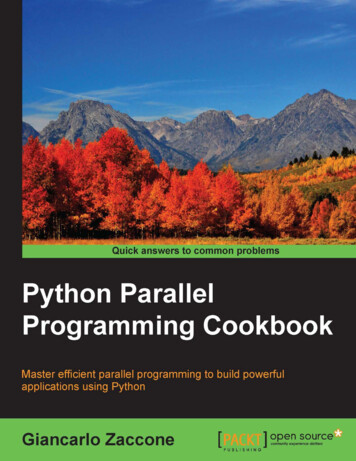
Transcription
Python ParallelProgrammingCookbookMaster efficient parallel programming to build powerfulapplications using PythonGiancarlo ZacconeBIRMINGHAM - MUMBAI
Python Parallel Programming CookbookCopyright 2015 Packt PublishingAll rights reserved. No part of this book may be reproduced, stored in a retrieval system, ortransmitted in any form or by any means, without the prior written permission of the publisher,except in the case of brief quotations embedded in critical articles or reviews.Every effort has been made in the preparation of this book to ensure the accuracy of theinformation presented. However, the information contained in this book is sold withoutwarranty, either express or implied. Neither the author, nor Packt Publishing, and its dealersand distributors will be held liable for any damages caused or alleged to be caused directly orindirectly by this book.Packt Publishing has endeavored to provide trademark information about all of the companiesand products mentioned in this book by the appropriate use of capitals. However, PacktPublishing cannot guarantee the accuracy of this information.First published: August 2015Production reference: 1210815Published by Packt Publishing Ltd.Livery Place35 Livery StreetBirmingham B3 2PB, UK.ISBN 978-1-78528-958-3www.packtpub.com
CreditsAuthorGiancarlo ZacconeReviewersAditya AvinashProject CoordinatorJudie JoseProofreaderSafis EditingRavi ChityalaMike GalloyLudovic GascCommissioning EditorSarah CroftonIndexerMariammal ChettiyarGraphicsSheetal AuteDisha HariaAcquisition EditorJason MonterioMeeta RajaniAbhinash SahuContent Development EditorRashmi SuvarnaTechnical EditorMrunmayee PatilCopy EditorNeha VyasProduction CoordinatorConidon MirandaCover WorkConidon Miranda
About the AuthorGiancarlo Zaccone has more than 10 years of experience in managing research projects,both in scientific and industrial domains. He worked as a researcher at the National ResearchCouncil (CNR), where he was involved in a few parallel numerical computing and scientificvisualization projects.He currently works as a software engineer at a consulting company, developing andmaintaining software systems for space and defense applications.Giancarlo holds a master's degree in physics from the University of Naples Federico II and hascompleted a second-level postgraduate master's program in scientific computing from theSapienza University of Rome.You can know more about him at https://it.linkedin.com/in/giancarlozaccone.
About the ReviewersAditya Avinash is a graduate student who focuses on computer graphics and GPUs. Hisareas of interest are compilers, drivers, physically based rendering, and real-time rendering.His current focus is on making a contribution to MESA (the open source graphics driverstack for Linux), where he will implement OpenGL extensions for the AMD backend. This issomething that he is really excited about. He also likes writing compilers to translate highlevel abstraction code into GPU code. He has developed Urutu, which gives GPUs threadlevel parallelism with Python. For this, NVIDIA funded him with a couple of Tesla K40 GPUs.Currently, he is working on RockChuck, translating the Python code (written using dataparallel abstraction) into GPU/CPU code, depending on the available backend. This projectwas started after he reviewed the opinions of a lot of Python programmers who wanted dataparallel abstraction for Python and GPUs.He has a computer engineering background, where he designed hardware and software to fitcertain applications (ASIC). From this, he gained experience of how to use FPGAs and HDLs.Apart from this, he mainly programs using Python and C . In C , he uses OpenGL, CUDA,OpenCL, and other multicore programming APIs. Since he is a student, most of his work isnot affiliated with any institution or person.Ravi Chityala is a senior engineer at Elekta Inc. He has more than 12 years of experiencein image processing and scientific computing. He is also a part time instructor at theUniversity of California, Santa Cruz Extension, San Jose, CA, where he teaches advancedPython to programmers. He began using Python as a scripting tool and fell in love with thelanguage's simplicity, power, and expressiveness. He now uses it for web development,scientific prototyping and computing, and he uses it as a glue to automate the process. Hecombined his experience in image processing and his love for Python and coauthored thebook Image Acquisition and Processing using Python, published by CRC Press.
Mike Galloy is a software developer who focuses on high-performance computing andvisualization in scientific programming. He works mostly on IDL, but occasionally uses C,CUDA, and Python. He currently works for the National Center for Atmospheric Research(NCAR) at the Mauna Loa Solar Observatory. Previously, he worked for Tech-X Corporation,where he was the main developer for GPULib, a library of IDL bindings for GPU-acceleratedcomputation routines. He is the creator and main developer of the open source projects,IDLdoc, mgunit, and rIDL, as well as the author of the book Modern IDL.Ludovic Gasc is a senior software developer and engineer at Eyepea and ALLOcloud, ahighly renowned open source VoIP and unified communications company in Europe.Over the last 5 years, he has developed redundant distributed systems for the telecom sectorthat are based on Python, AsyncIO, PostgreSQL, and Redis.You can contact him on his blog at http://www.gmludo.eu.He is also the creator of the blog API-Hour: Write efficient network daemons (HTTP, SSH) withease. For more information, visit http://www.api-hour.io.
www.PacktPub.comSupport files, eBooks, discount offers, and moreFor support files and downloads related to your book, please visit www.PacktPub.com.Did you know that Packt offers eBook versions of every book published, with PDF and ePubfiles available? You can upgrade to the eBook version at www.PacktPub.com and as a printbook customer, you are entitled to a discount on the eBook copy. Get in touch with us atservice@packtpub.com for more details.At www.PacktPub.com, you can also read a collection of free technical articles, sign up fora range of free newsletters and receive exclusive discounts and offers on Packt books iption/packtlibDo you need instant solutions to your IT questions? PacktLib is Packt's online digital booklibrary. Here, you can search, access, and read Packt's entire library of books.Why Subscribe?ffFully searchable across every book published by PacktffCopy and paste, print, and bookmark contentffOn demand and accessible via a web browserFree Access for Packt account holdersIf you have an account with Packt at www.PacktPub.com, you can use this to accessPacktLib today and view 9 entirely free books. Simply use your login credentials for immediateaccess.
Table of ContentsPrefaceChapter 1: Getting Started with Parallel Computing and Pythonv1IntroductionThe parallel computing memory architectureMemory organizationParallel programming modelsHow to design a parallel programHow to evaluate the performance of a parallel programIntroducing PythonPython in a parallel worldIntroducing processes and threadsStart working with processes in PythonStart working with threads in Python2361416192126262729Chapter 2: Thread-based Parallelism33IntroductionUsing the Python threading moduleHow to define a threadHow to determine the current threadHow to use a thread in a subclassThread synchronization with Lock and RLockThread synchronization with RLockThread synchronization with semaphoresThread synchronization with a conditionThread synchronization with an eventUsing the with statementThread communication using a queueEvaluating the performance of multithread applications34353537394145485255596266i
Table of ContentsChapter 3: Process-based ParallelismIntroductionHow to spawn a processHow to name a processHow to run a process in the backgroundHow to kill a processHow to use a process in a subclassHow to exchange objects between processesHow to synchronize processesHow to manage a state between processesHow to use a process poolUsing the mpi4py Python modulePoint-to-point communicationAvoiding deadlock problemsCollective communication using broadcastCollective communication using scatterCollective communication using gatherCollective communication using AlltoallThe reduction operationHow to optimize 14116118120Chapter 4: Asynchronous Programming127Chapter 5: Distributed Python151IntroductionUsing the concurrent.futures Python modulesEvent loop management with AsyncioHandling coroutines with AsyncioTask manipulation with AsyncioDealing with Asyncio and FuturesIntroductionUsing Celery to distribute tasksHow to create a task with CeleryScientific computing with SCOOPHandling map functions with SCOOPRemote Method Invocation with Pyro4Chaining objects with Pyro4Developing a client-server application with Pyro4Communicating sequential processes with PyCSPUsing MapReduce with DiscoA remote procedure call with 4190195
Table of ContentsChapter 6: GPU Programming with Python199Index257IntroductionUsing the PyCUDA moduleHow to build a PyCUDA applicationUnderstanding the PyCUDA memory model with matrix manipulationKernel invocations with GPUArrayEvaluating element-wise expressions with PyCUDAThe MapReduce operation with PyCUDAGPU programming with NumbaProUsing GPU-accelerated libraries with NumbaProUsing the PyOpenCL moduleHow to build a PyOpenCL applicationEvaluating element-wise expressions with PyOpenClTesting your GPU application with PyOpenCL200201207212218220225229234240243248251iii
PrefaceThe study of computer science should cover not only the principles on which computationalprocessing is based, but should also reflect the current state of knowledge of these fields.Today, the technology requires that professionals from all branches of computer science knowboth the software and hardware whose interaction at all levels is the key to understanding thebasics of computational processing.For this reason, in this book, a special focus is given on the relationship between hardwarearchitectures and software.Until recently, programmers could rely on the work of the hardware designers, compilers,and chip manufacturers to make their software programs faster or more efficient withoutthe need for changes.This era is over. So now, if a program is to run faster, it must become a parallel program.Although the goal of many researchers is to ensure that programmers are not aware of theparallel nature of the hardware for which they write their programs, it will take many yearsbefore this actually becomes possible. Nowadays, most programmers need to thoroughlyunderstand the link between hardware and software so that the programs can be runefficiently on modern computer architectures.To introduce the concepts of parallel programming, the Python programming language hasbeen adopted. Python is fun and easy to use, and its popularity has grown steadily in recentyears. Python was developed more than 10 years ago by Guido van Rossum, who derivedPython's syntax simplicity and ease of use largely from ABC, which is a teaching languagethat was developed in the 80s.v
PrefaceIn addition to this specific context, Python was created to solve real-life problems, and itborrows a wide variety of typical characteristics of programming languages, such as C ,Java, and Scheme. This is one of its most remarkable features, which has led to its broadappeal among professional software developers, the scientific research industry, andcomputer science educators. One of the reasons why Python is liked so much is becauseit provides the best balance between the practical and conceptual approaches. It is aninterpreted language, so you can start doing things immediately without getting lost in theproblems of compilation and linking. Python also provides an extensive software library thatcan be used in all sorts of tasks ranging from the Web, graphics, and of course, parallelcomputing. This practical aspect is a great way to engage readers and allow them to carry outprojects that are important in this book.This book contains a wide variety of examples that are inspired by many situations, andthese offer you the opportunity to solve real-life problems. This book examines the principlesof software design for parallel architectures, insisting on the importance of clarity of theprograms and avoiding the use of complex terminology in favor of clear and direct examples.Each topic is presented as part of a complete, working Python program, which is followed bythe output of the program in question.The modular organization of the various chapters provides a proven path to move from thesimplest arguments to the most advanced ones, but this is also suitable for those who onlywant to learn a few specific issues.I hope that the settings and content of this book are able to provide you with a usefulcontribution for your better understanding and dissemination of parallel programmingtechniques.What this book coversChapter 1, Getting Started with Parallel Computing and Python, gives you an overview ofparallel programming architectures and programming models. This chapter introduces thePython programming language, the characteristics of the language, its ease of use andlearning, extensibility, and richness of software libraries and applications. It also showsyou how to make Python a valuable tool for any application, and also, of course, for parallelcomputing.Chapter 2, Thread-based Parallelism, discusses thread parallelism using the threading Pythonmodule. Through complete programming examples, you will learn how to synchronize andmanipulate threads to implement your multithreading applications.Chapter 3, Process-based Parallelism, will guide through the process-based approachto parallelize a program. A complete set of examples will show you how to use themultiprocessing Python module. Also, this chapter will explain how to perform communicationthrough processes, using the message passing parallel programming paradigm via the mpi4pyPython module.vi
PrefaceChapter 4, Asynchronous Programming, explains the asynchronous model for concurrentprogramming. In some ways, it is simpler than the threaded one because there is a singleinstruction stream and tasks explicitly relinquish control instead of being suspendedarbitrarily. This chapter will show you how to use the Python asyncio module to organize eachtask as a sequence of smaller steps that must be executed in an asynchronous manner.Chapter 5, Distributed Python, introduces you to distributed computing. It is the process ofaggregating several computing units logically and may even be geographically distributedto collaboratively run a single computational task in a transparent and coherent way. Thischapter will present some of the solutions proposed by Python for the implementation ofthese architectures using the OO approach, Celery, SCOOP, and remote procedure calls, suchas Pyro4 and RPyC. It will also include different approaches, such as PyCSP, and finally, Disco,which is the Python version of the MapReduce algorithm.Chapter 6, GPU Programming with Python, describes the modern Graphics ProcessingUnits (GPUs) that provide breakthrough performance for numerical computing at the cost ofincreased programming complexity. In fact, the programming models for GPUs require theprogrammer to manually manage the data transfer between a CPU and GPU. This chapter willteach you, through the programming examples and use cases, how to exploit the computingpower provided by the GPU cards, using the powerful Python modules: PyCUDA, NumbaPro,and PyOpenlCL.What you need for this bookAll the examples of this book can be tested in a Windows 7 32-bit machine. Also, a Linuxenvironment will be useful.The Python versions needed to run the examples are:ffPython 3.3 (for the first five chapters)ffPython 2.7 (only for Chapter 6, GPU Programming with Python)The following modules (all of which are freely downloadable) are required:ffmpich-3.1.4ffpip 6.1.1ffmpi4py1.3.1ffasyncio 3.4.3ffCelery 3.1.18ffNumpy 1.9.2ffFlower 0.8.32 (optional)ffSCOOP 0.7.2vii
PrefaceffPyro 4.4.36ffPyCSP 0.9.0ffDISCO 0.5.2ffRPyC 3.3.0ffPyCUDA 2015.1.2ffCUDA Toolkit 4.2.9 (at least)ffNVIDIA GPU SDK 4.2.9 (at least)ffNVIDIA GPU driverffMicrosoft Visual Studio 2008 C Express Edition (at least)ffAnaconda Python DistributionffNumbaPro compilerffPyOpenCL 2015.1ffWin32 OpenCL Driver 15.1 (at least)Who this book is forThis book is intended for software developers who want to use parallel programmingtechniques to write powerful and efficient code. After reading this book, you will be able tomaster the basics and the advanced features of parallel computing. The Python programminglanguage is easy to use and allows nonexperts to deal with and easily understand the topicsexposed in this book.SectionsThis book contains the following sections:Getting readyThis section tells us what to expect in the recipe and describes how to set up any software orany preliminary settings needed for the recipe.How to do it This section characterizes the steps that are to be followed to "cook" the recipe.viii
PrefaceHow it works This section usually consists a brief and detailed explanation of what happened in theprevious section.There's more This section consists of additional information about the recipe in order to make the readermore anxious about the recipe.See alsoThis section may contain references to the recipe.ConventionsIn this book, you will find a number of styles of text that distinguish between different kinds ofinformation. Here are some examples of these styles, and an explanation of their meaning.Code words in text, database table names, folder names, filenames, file extensions,pathnames, dummy URLs, user input, and Twitter handles are shown as follows: "To executethis first example, we need the program helloPythonWithThreads.py."A block of code is set as follows:print ("Hello Python Parallel Cookbook!!")closeInput raw input("Press ENTER to exit")print "Closing calledProcess"When we wish to draw your attention to a particular part of a code block, the relevant lines oritems are set in bold:@asyncio.coroutinedef factorial(number):do Something@asyncio.coroutineAny command-line input or output is written as follows:C:\ mpiexec -n 4 python virtualTopology.pyix
PrefaceNew terms and important words are shown in bold. Words that you see on the screen, inmenus or dialog boxes for example, appear in the text like this: "Open an admin CommandPrompt by right-clicking on the command prompt icon and select Run as administrator."Warnings or important notes appear in a box like this.Tips and tricks appear like this.Reader feedbackFeedback from our readers is always welcome. Let us know what you think about thisbook—what you liked or may have disliked. Reader feedback is important for us to developtitles that you really get the most out of.To send us general feedback, simply send an e-mail to feedback@packtpub.com, andmention the book title via the subject of your message.If there is a topic that you have expertise in and you are interested in either writing orcontributing to a book, see our author guide on www.packtpub.com/authors.Customer supportNow that you are the proud owner of a Packt book, we have a number of things to help you toget the most from your purchase.Downloading the example codeYou can download the example code files for all Packt books you have purchased from youraccount at http://www.packtpub.com. If you purchased this book elsewhere, you canvisit http://www.packtpub.com/support and register to have the files e-mailed directlyto you.x
PrefaceErrataAlthough we have taken every care to ensure the accuracy of our content, mistakes dohappen. If you find a mistake in one of our books—maybe a mistake in the text or the code—we would be grateful if you would report this to us. By doing so, you can save other readersfrom frustration and help us improve subsequent versions of this book. If you find any errata,please report them by visiting http://www.packtpub.com/submit-errata, selectingyour book, clicking on the errata submission form link, and entering the details of yourerrata. Once your errata are verified, your submission will be accepted and the errata willbe uploaded on our website, or added to any list of existing errata, under the Errata sectionof that title. Any existing errata can be viewed by selecting your title from http://www.packtpub.com/support.PiracyPiracy of copyright material on the Internet is an ongoing problem across all media. At Packt,we take the protection of our copyright and licenses very seriously. If you come across anyillegal copies of our works, in any form, on the Internet, please provide us with the locationaddress or website name immediately so that we can pursue a remedy.Please contact us at copyright@packtpub.com with a link to the suspected piratedmaterial.We appreciate your help in protecting our authors, and our ability to bring you valuablecontent.QuestionsYou can contact us at questions@packtpub.com if you are having a problem with anyaspect of the book, and we will do our best to address it.xi
1Getting Started withParallel Computingand PythonIn this chapter, we will cover the following recipes:ffWhat is parallel computing?ffThe parallel computing memory architectureffMemory organizationffParallel programming modelsffHow to design a parallel programffHow to evaluate the performance of a parallel programffIntroducing PythonffPython in a parallel worldffIntroducing processes and threadsffStart working with processes and PythonffStart working with threads and Python1
Getting Started with Parallel Computing and PythonIntroductionThis chapter gives you an overview of parallel programming architectures and programmingmodels. These concepts are useful for inexperienced programmers who have approachedparallel programming techniques for the first time. This chapter can be a basic referencefor the experienced programmers. The dual characterization of parallel systems is alsopresented in this chapter. The first characterization is based on the architecture of thesystem and the second characterization is based on parallel programming paradigms.Parallel programming will always be a challenge for programmers. This programming-basedapproach is further described in this chapter, when we present the design procedure of aparallel program. The chapter ends with a brief introduction of the Python programminglanguage. The characteristics of the language, ease of use and learning, and extensibilityand richness of software libraries and applications make Python a valuable tool for anyapplication and also, of course, for parallel computing. In the final part of the chapter, theconcepts of threads and processes are introduced in relation to their use in the language.A typical way to solve a problem of a large-size is to divide it into smaller and independentparts in order to solve all the pieces simultaneously. A parallel program is intended for aprogram that uses this approach, that is, the use of multiple processors working togetheron a common task. Each processor works on its section (the independent part) of theproblem. Furthermore, a data information exchange between processors could take placeduring the computation. Nowadays, many software applications require more computingpower. One way to achieve this is to increase the clock speed of the processor or to increasethe number of processing cores on the chip. Improving the clock speed increases the heatdissipation, thereby decreasing the performance per watt and moreover, this requires specialequipment for cooling. Increasing the number of cores seems to be a feasible solution, aspower consumption and dissipation are way under the limit and there is no significant gain inperformance.To address this problem, computer hardware vendors decided to adopt multi-corearchitectures, which are single chips that contain two or more processors (cores). On theother hand, the GPU manufactures also introduced hardware architectures based on multiplecomputing cores. In fact, today's computers are almost always present in multiple andheterogeneous computing units, each formed by a variable number of cores, for example, themost common multi-core architectures.Therefore, it became essential for us to take advantage of the computational resourcesavailable, to adopt programming paradigms, techniques, and instruments of parallelcomputing.2
Chapter 1The parallel computing memory architectureBased on the number of instructions and data that can be processed simultaneously,computer systems are classified into four categories:ffSingle instruction, single data (SISD)ffSingle instruction, multiple data (SIMD)ffMultiple instruction, single data (MISD)ffMultiple instruction, multiple data (MIMD)This classification is known as Flynn's taxonomy.SISDSIMDSingle InstructionSingle DataSingle InstructionMultiple DataMISDMultiple InstructionsSingle DataMultiple InstructionsMultiple DataSISDThe SISD computing system is a uniprocessor machine. It executes a single instruction thatoperates on a single data stream. In SISD, machine instructions are processed sequentially.In a clock cycle, the CPU executes the following operations:ffFetch: The CPU fetches the data and instructions from a memory area, which iscalled a register.ffDecode: The CPU decodes the instructions.ffExecute: The instruction is carried out on the data. The result of the operation isstored in another register.3
Getting Started with Parallel Computing and PythonOnce the execution stage is complete, the CPU sets itself to begin another CPU cycle.ControlInstructionDataProcessorMemoryThe SISD architecture schemaThe algorithms that run on these types of computers are sequential (or serial), since theydo not contain any parallelism. Examples of SISD computers are hardware systems witha single CPU.The main elements of these architectures (Von Neumann architectures) are:ffCentral memory unit: This is used to store both instructions and program dataffCPU: This is used to get the instruction and/or data from the memory unit, whichdecodes the instructions and sequentially implements themffThe I/O system: This refers to the input data and output data of the programThe conventional single processor computers are classified as SISD systems. The followingfigure specifically shows which areas of a CPU are used in the stages of fetch, decode, andexecute:FetchDecodeExecuteArithmetic LogicUnitControl UnitRegistersDecode UnitDataCacheBus UnitInstructionCacheCPU's components in the fetch-decode-execute phase4
Chapter 1MISDIn this model, n processors, each with their own control unit, share a single memory unit.In each clock cycle, the data received from the memory is processed by all processorssimultaneously, each in accordance with the instructions received from its control unit. Inthis case, the parallelism (instruction-level parallelism) is obtained by performing severaloperations on the same piece of data. The types of problems that can be solved efficientlyin these architectures are rather special, such as those regarding data encryption; for thisreason, the computer MISD did not find space in the commercial sector. MISD computers aremore of an intellectual exercise than a practical configuration.MemoryDataProcessor 1Instruction 1Control 1DataProcessor 2Instruction 2Control 2DataProcessor NInstruction NControl NThe MISD architecture schemeSIMDA SIMD computer consists of n identical processors, each with its own local memory, whereit is possible to store data. All processors work under the control of a single instructionstream; in addition to this, there are n data streams, one for each processor. The processorswork simultaneously on each step and execute the same instruction, but on different dataelements. This is an example of data-level parallelism. The SIMD architectures are much moreversatile than MISD architectures. Numerous problems covering a wide range of applicationscan be solved by parallel algorithms on SIMD computers. Another interesting feature is thatthe algorithms for these computers are relatively easy to design, analyze, and implement. Thelimit is that only the problems that can be divided into a number of subproblems (which areall identical, each of which will then be solved contemporaneously, through the same set ofinstructions) can be addressed with the SIMD computer. With the supercomputer developedaccording to this paradigm, we must mention the Connection Machine (1985 ThinkingMachine) and MPP (NASA - 1983). As we will see in Chapter 6, GPU Programming with Python,the advent of modern graphics processor unit (GPU), built with many SIMD embedded unitshas lead to a more widespread use of this computational paradigm.5
Getting Started with Parallel Computing and PythonMIMDThis class of parallel computers is the most general and more powerful class according toFlynn's classification. There are n processors, n instruction streams, and n data streamsin this. Each processor has its own control unit and local memory, which makes MIMDarchitectures more computationally powerful than those used in SIMD. Each processoroperates under the control of a flow of instructions issued by its own control unit; therefore,the processors can potentially run different programs on different data, solving subproblemsthat are different and can be a part of a single larger problem. In MIMD, architecture isachieved with the help of the parallelism level with threads and/or processes. This alsomeans that the processors usually operate asynchronously. The computers in this classare used to solve those problems that do not have a regular structure that is required bythe model SIMD. Now
Currently, he is working on RockChuck, translating the Python code (written using data parallel abstraction) into GPU/CPU code, depending on the available backend. This project was started after he reviewed the opinions of a lot of Python programmers who wanted data parallel abstraction for Python and GPUs.


